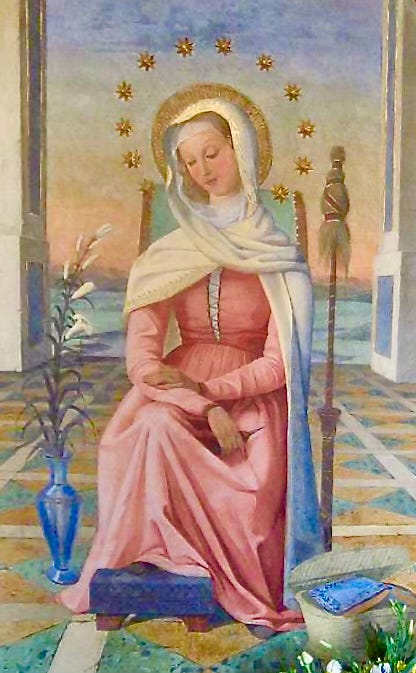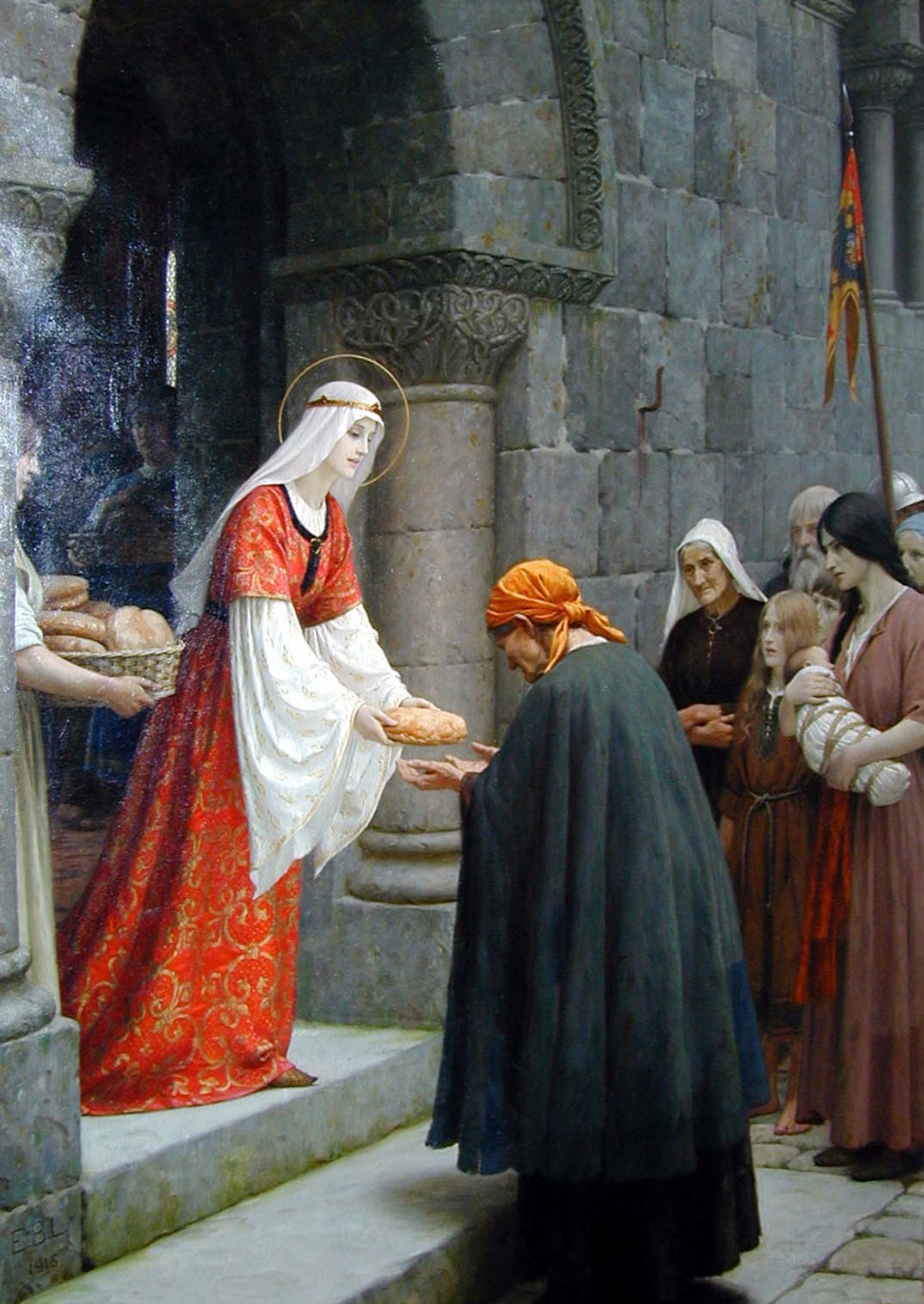Inside the Walls: Fashion for Catholic Women
How we might honor God through colors, style, and beauty.
“Those countries in Europe which are still influenced by priests, are exactly the countries where there is still singing and dancing and coloured dresses and art in the open-air. Catholic doctrine and discipline may be walls; but they are the walls of a playground.”
So said G.K. Chesterton, in words upon which I cannot improve. Time and time again, it has been Catholicism which has cultivated truer, deeper beauty in all things, more so than any other faith. Yet, especially since the advent of communism, questions are raised again, and whether fashion has a place, is one of them. Is it important to us as Catholics, or is it merely an occasion of materialism? While it is certainly of lesser import than other issues, it is one all of us have to deal with in one way or another. Many of us struggle with finding modest, but pretty clothing; others have the issue of whether we ought to dress austerely; and others seem to be concerned that Biblical garb should be the norm.
Many of us, considering the Lilies of the Field, have probably wondered whether fashion has a place in Catholicism. I used to ask myself this often. While I was in college, one of the men told me that my fashion design was, in essence, worth nothing compared to his endeavoring to create a new school of philosophy. This was shortly after I had at last received the answer to my struggle of aligning my love of fashion design with Catholicism, so needless to say, his words were like only oil on water.
The answer God had given me was that of Genesis 3:21:
“And the Lord God made for Adam and his wife, garments of skins, and clothed them.”
If God was the first designer and creator of clothing, then my fashion designing skills have a place. In a world where the majority of designs aren’t made with God, beauty, or modesty in mind, it is important to have at least a corner where these things are held in importance.
Beyond this, I would consider that fashion has more than the primary purpose of modesty: it also helps us to express ourselves, finding out how unique we are and therefore how special we each are in God’s eyes; it can aid in evangelization by beauty; and, as God is a Father who loves His children, I think He is happy when we play with the things He gives us, including colors, inspiration, and fibres, just to name a few.
As St. Therese’s sister Celine said, “From the moment we first seek His kingdom and His justice, He is happy with us. And I am certain that even in occupations which did not have eternity as their immediate goal, I always gave myself up to them with the intention of finding there some beauty which would bring me closer to my Creator.”
Color
A look at the flowers, the rainbow, butterflies, and birds, and the whole of Creation tells us that God loves color and beauty: both the earth tones and that of the rainbow. Even species of spider and wasp have the gift of metallic, glorious iridescence, and there are turquoise cockroaches which look like they might have been some adornment out of Ancient Egypt.
God is an artist who loves to play with color and design, and a Father who enjoys seeing us play with His colors and inspirations, for this is one of the “playgrounds” which He has given us. We see Catholicism celebrates this in the richly symbolic colors of liturgical vestments, and we further see the detailed embroidery and laces used, denoting the priest as the symbol of Christ. Another source for inspiration are the numerous miraculous images of Our Lady and her apparitions.
Style
Regarding style, the walls are modesty, humility, love, and mindfulness. Within, we have anything from elegant simplicity to bold structure. The key is to glorify God in all things, and one way to do it is to honor the uniqueness He’s given us. The way we dress is a reminder to ourselves that we are the Temple of the Holy Spirit, granting us a dignity we don’t often realize, and this Temple should be covered as such.
Further, unlike the trends which tend to make society look alike, each of us is unique in personality, life, vocation, and physique, just to name a handful. The more we become truly our individual selves, the more we become who God created. We are not a copy, but an original. It helps us realize our worth and irreplaceability to Him, so that even what we wear, if mindful, can keep us from straying or being lost.
Maria “Teresita” Quevedo understood that being one’s unique, individual self is something important to God.
“Even her motto, “Mother, may those who see me, see you,” didn’t make her bland and uninteresting. . . .Teresita understood well that holiness is being fully alive, fully yourself, for the glory of God. So the girl who longed to be a saint was elected best dressed in her class, became captain of the basketball team, and loved to watch bullfights. . . .But for Teresita, it was love of the Lord and his Mother that really mattered.”1
Beauty
Fashion may be one of, if not the only, things strangers see about us in passing. Beauty is a form of evangelization, which the Church has always used in her music, liturgy, stained glass, art, and the like. Many non-Catholics are drawn to places such as Chartres, Sainte-Chapelle, and Notre-Dame to bathe in the magnificent colored lights, which are in themselves a strange window into Heaven. In a world full of the destruction of the true, good, and beautiful, beauty is important; it can draw souls to God even before truth, healing, and light.

I mentioned a few weeks ago that the aforementioned Blessed Maria Quevedo was the best dressed girl in her class and appreciated fashion. When entering the convent, her wedding dress was so lovely that others thought it was too much for one dedicating herself to God. To paraphrase, Maria replied, “Do you not think that God loves beautiful things?”
We ought to dress as a reflection of the beauty and perfect holiness of our Creator, in modesty, whether in simplicity or in adornment.
“For she is the brightness of eternal light, and the unspotted mirror of God's majesty, and the image of his goodness.” (Wisdom 7:26)
Leaving Fashion Out
The result of leaving fashion out of Catholicism? The fashion world itself is filled with drugs, impurity, ugliness, materialism, and, as many of us have experienced, one result is that it is hard to find modest and inexpensive clothing that works for us. Not to mention, many designers are men and tend not to design the clothing we actually want to wear, which makes it more difficult.
The few Catholic clothing companies I’ve seen haven’t done much better than secular except in intention, and they’re hard to find. Whenever I search for Catholic fashion, all that the search returns to me are headings of the disastrous Met gala, which took inspiration from Catholicism in inappropriate ways. There are a number of Christian brands, which while much more modest, tend to be plain, as well. For myself, while my desire of creating a Catholic clothing company is unlikely to happen, I design and create my own clothing, which may be an option for those of you who enjoy sewing.
How To Exercise Mindfulness of God In Fashion
How can we make fashion beneficial to us as Catholics, beyond its practical use? Besides beauty and modesty, there are a few things we can try.
Using our uniqueness, in what suits the way God created us, both physically and in personality, to realize how irreplaceable we are to Him. Some methods which I’ve personally found enjoyable and helpful, are the Kibby body-typing system, style essences, and color seasons. Bear in mind that, as I’ve found, you can easily be a blend of multiple types, essences, and seasons. Please remember that you can always wear something that you enjoy, even if it doesn’t match what these forms would tell you. The website I typically reference for these are (these are for ladies only, as I have none for men):
Bear in mind that these are, unfortunately, secular sources and so the pictures for the Kibbe system and style essences are not as modest as we’d like.
Secondly, we can use color symbolism to help keep us mindful of God and Our Lady in our day to day. For example, an exercise I’ve been trying to implement for myself might run like this:
If I choose a vintage dress which is the deepest navy blue with pink roses and green and white leaves, I tell myself that the navy will keep me mindful of Our Lady’s sorrows; the pink of her joy and God’s love; the green for hope and Christ’s resurrection; the white for healing. I do the same with any jewelry I might wear – a locket, for instance, to think of the Sacred Heart. Then, I can occasionally return to that throughout the day and meditate upon one of these thoughts.
One method I’m sure many of us have recourse to is matching the colors we wear to the feast day or liturgical vestments – red for martyr-days, blue for Marian feasts, shades of purple for Lent and Advent.
Remembering the Lilies of the Field in simplicity, dependence on God, and as a reminder not to overly worried or concerned about anything, or being lost in the materialism.
If you have any thoughts on this topic, as it is definitely of varying opinions, or any other ideas for how we can use fashion to honor God, I’d love to hear them!
Hunter-Kilmer, Meg. “Fully alive: The “little terror” who wanted to be a saint.” Aleteia. July 20th, 2017. https://aleteia.org/2017/07/20/fully-alive-the-little-terror-who-wanted-to-be-a-saint/.







A friendly reminder that this is a family-friendly zone, so please refrain from using inappropriate language, aggressive or violent tones, or sharing links, as such comments will be deleted as a safety measure. Thank you for understanding!
I love your thoughts about beauty! Indeed, "beauty is a form of evangelization." The problem today is that the world is gradually losing its sense of the beautiful and the good. I hope we can bring back the kind of beauty that lifts the human heart and soul towards heaven itself.